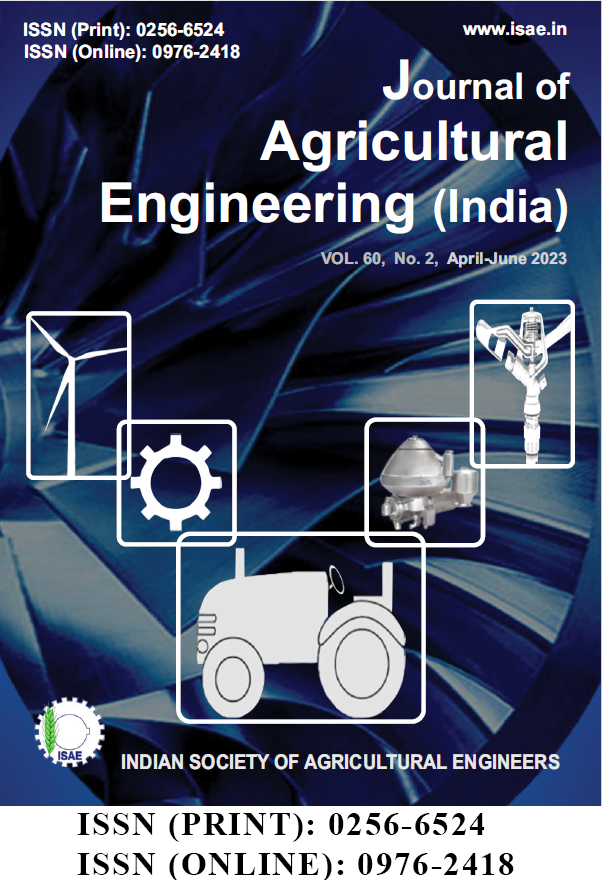Energy Input-Output Analyses of Major Field Vegetable Crops Production in Punjab
DOI:
https://doi.org/10.52151/jae2023602.1801Keywords:
Energy consumption, mechanisation, renewable energy, vegetable cropAbstract
The energy consumption pattern in Indian agriculture has changed with a marked shift from human and animal power to electrical and mechanical sources of energy (tractors, diesel engines, self-propelled machines). The rising cost of production and depleting energy sources are paramount concerns for the maximization of productivity with minimum input of energy and cost. A study was performed for determining the energy productivity of five major vegetable crops (potato, tomato, muskmelon, garden pea, cauliflower) production systems. Significantly higher (p<0.05) energy consumption was observed for potato cultivation (53,412 ± 2,388 MJ.ha-1), followed by tomato (47,489 ± 1,183 MJ.ha-1), cauliflower (39,367 ± 1,127 MJ.ha-1), muskmelon (37,827 ± 856 MJ.ha-1), and garden pea (24,625 ± 497 MJ.ha-1). Irrigation was observed to be the major energy-consuming farm operation, followed by transportation of farmyard manure (FYM)/fertilisers and produce. Based on the significant contribution of non-renewable and commercial energy in the production of major vegetable crops, the agricultural system was observed to be vulnerable to increase in energy prices through petroleum as well as fertiliser prices. There is a need to include more energy- and cost-effective farm mechanisation and irrigation systems.
References
Anon. 2020. Statistical Abstract of Punjab. Economic Adviser to Government of Punjab, Chandigarh, No. 962, 183-199.
Anon. 2021. Statement on Climate of India 2020. Climate Research and Services, India Meteorological Department, Government of India, New Delhi, pp: 11.
Anon. 2022. Statement on Climate of India 2021. Climate Research and Services, India Meteorological Department, Government of India, New Delhi, pp: 9.
Anon. 2023. Statement on Climate of India 2022. Climate Research and Services, India Meteorological Department, Government of India, New Delhi, pp: 11.
Bilalis D; Kamariari; Karkanis; Efthimiadou; Zorpas A; Kakabouki I. 2013. Energy inputs, output and productivity in organic and conventional maize and tomato production under mediterranean conditions. Notulae Botanicae Horti Agrobotanici Cluj-Napoca, 41, 190-194. https://doi.org/10.15835/nbha4119081
Jat H S; Jat R D; Nanwal R K; Lohan S K; Yadav A K; Poonia T; Sharma P C; Jat M L. 2020. Energy-use efficiency of crop residue management for sustainable energy and agriculture conservation in NW India. Renewable Energy, 155, 1372-1382.
Kumar R; Kaur A. 2018. Statistics of Punjab Agriculture. Punjab Agricultural University, Ludhiana, pp: 66.
Kuswardhani N; Soni P; Ganesh P; Shivakoti B. 2013. Comparative energy input output and financial analyses of greenhouse and open field vegetables production in West Java, Indonesia. Energy, 53, 83-92.
Lin H C; Huber J A; Gerl G; Hulsbergen K J. 2017. Effects of changing farm management and farm structure on energy balance and energy-use efficiency—a case study of organic and conventional farming systems in Southern Germany. Eur. J. Agron., 82, 242-253.
Lohan S K; Narang M K; Manes G S. 2015. Farm power availability for sustainable agriculture development in Punjab, India. Agric. Eng. Int. CIGR J., 17, 196–207.
Mehta C R; Chandel N S; Senthilkumar T. 2014. Status, challenges and strategies for farm mechanisation in India. Agric. Mech. Asia Afr. Lat. Am., 45, 43-50.
Panesar B S; Bhatnagar A P. 1994. Energy norms for inputs and outputs of Agricultural Sector. In: Verma S R; Mittal J P; Singh S (Eds.) Energy Management and Conservation in Agricultural Production and Food Processing, UGC Publishers and Distributers, Ludhiana, 5-16.
Raghuvanshi M S; Tewari J C; Pareek K; Landol S; Raza M; Stanzin J. 2018. Energy budget of crops and weed management to enhance crop productivity in cold arid Ladakh region. Defence Life Sci. J., 3(2), 157-161. doi: 10.14429/dlsj.3.12568
Sepat N K; Sepat S R; Sepat S; Kumar A. 2013. Energy use efficiency and cost analysis of tomato under green house and open field production system at Nubra valley of Jammu and Kashmir. Int. J. Environ. Sci., 3, 1233-1241.
Sharma S; Manhas S S; Sharma R M; Lohan S K. 2014. Potential of variable rate application technology in India. Agric. Mech. Asia Afr. Lat. Am., 45, 74-81.
Singh K. 2012. Electricity subsidy in Punjab agriculture: Extent and Impact. Indian J. Agric. Econ., 67, 617-632.














